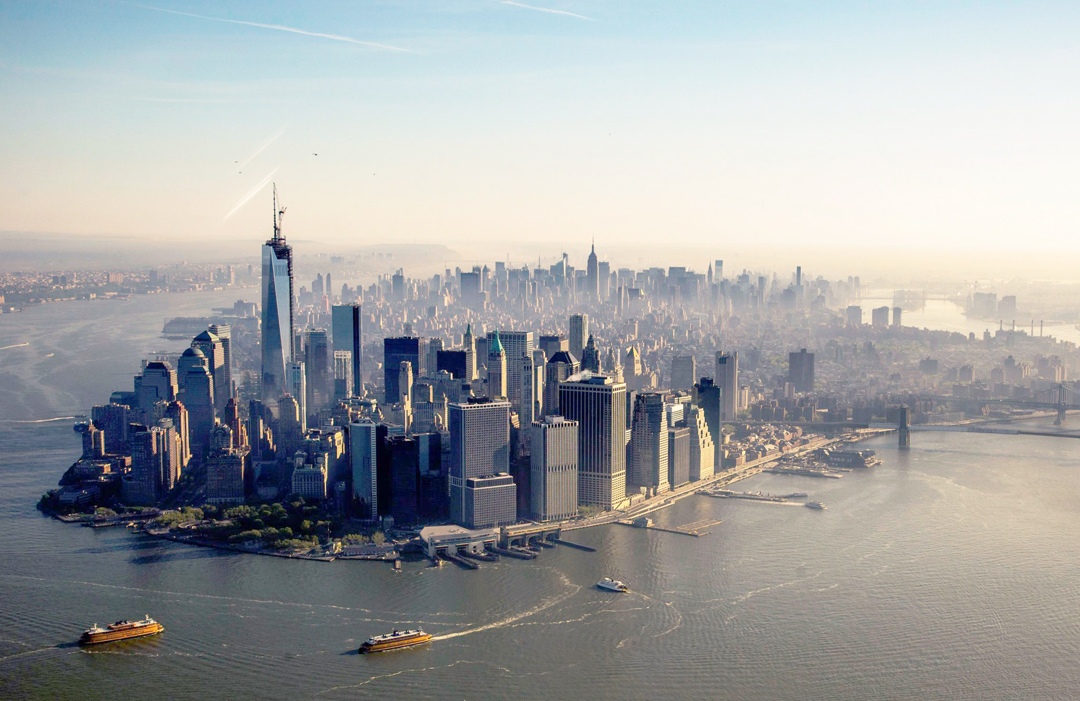

We have just returned from a week’s trip to those fleshpots of the East Coast, Philadelphia and New York City. This trip had been in the making for some time, most especially the NYC segment.
Although I grew up in NYC (in Da Bronx) I had actually seen very few of the sights there, a situation that’s not unusual among natives of major tourist destinations. My parents did make it a point to take us to various museums and so forth as kids, but that was many, many years ago. In the years since I moved away to go to college, serve in the Air Force, and follow my career, whenever we made the trek to NYC it was to visit relatives. I'm retired now, and have no more relatives whom I must visit in the City, so my wife and I were finally able to fulfill our long-held wish to be “out of towners.” Accordingly we drove from bucolic and rustic southwestern Virginia, with hay in our hair and hope in our hearts, making stops along the way to visit two sets of friends who’d left Blacksburg. One couple lived outside of Philadelphia, so we took the opportunity to stop on the way up and see a bit of that city.
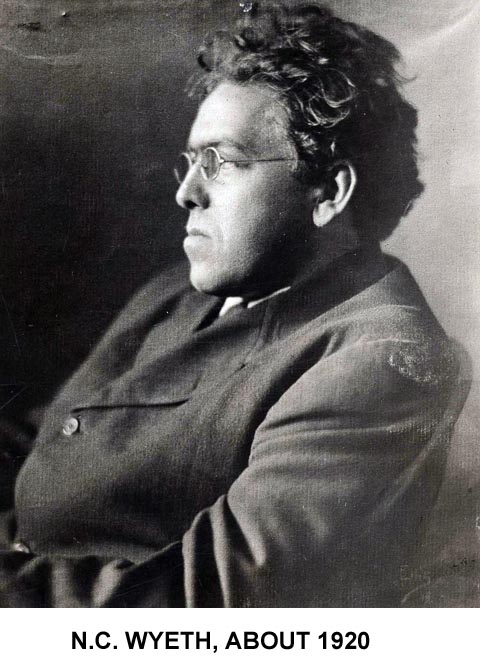
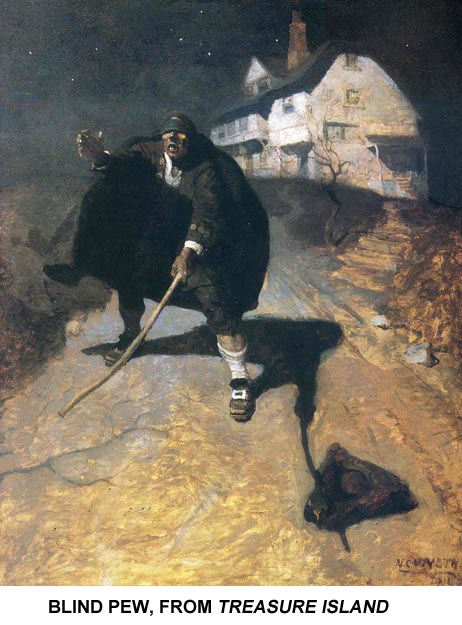 We spent some time at the Brandywine River Museum in Chadd's Ford, home to a collection of art by the Wyeth Family: N.C. Wyeth, his son Andrew, and Andrew’s son, Jamie. Of the three, N.C. was, in my opinion, the greatest artist. He simply had no peer, certainly not his son or grandson, as talented as they were in their own right. N.C. made his fame (and his money) illustrating books and magazine articles, for which he is sometimes contemptuously pooh-poohed by the sort of critics who think that random splotches of paint are “true art,” and representative painting is “bourgeois commercialism.” But anyone who has seen the illustrations for classics
We spent some time at the Brandywine River Museum in Chadd's Ford, home to a collection of art by the Wyeth Family: N.C. Wyeth, his son Andrew, and Andrew’s son, Jamie. Of the three, N.C. was, in my opinion, the greatest artist. He simply had no peer, certainly not his son or grandson, as talented as they were in their own right. N.C. made his fame (and his money) illustrating books and magazine articles, for which he is sometimes contemptuously pooh-poohed by the sort of critics who think that random splotches of paint are “true art,” and representative painting is “bourgeois commercialism.” But anyone who has seen the illustrations for classics 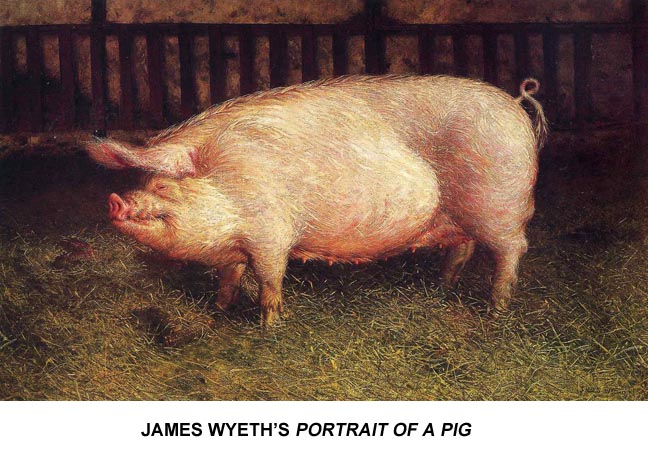 like Treasure Island and Kidnapped, the moving cover image from Botany Bay, or any of N.C.'s other work understands this to be hogwash. N.C. had the facility for painting scenes that were dramatic in nature, and his techniques of depicting light and dark are unmatched by anyone except perhaps Rembrandt. Andrew could paint when he wanted to, and Jamie too, but too often they didn’t want to. There are exceptions: Jamie’s Portrait of a Pig is a striking work, one I’d like to own myself; but it’s not to be compared with N.C.’s depiction of Blind Pew in Treasure Island!
like Treasure Island and Kidnapped, the moving cover image from Botany Bay, or any of N.C.'s other work understands this to be hogwash. N.C. had the facility for painting scenes that were dramatic in nature, and his techniques of depicting light and dark are unmatched by anyone except perhaps Rembrandt. Andrew could paint when he wanted to, and Jamie too, but too often they didn’t want to. There are exceptions: Jamie’s Portrait of a Pig is a striking work, one I’d like to own myself; but it’s not to be compared with N.C.’s depiction of Blind Pew in Treasure Island!
In Philly itself we spent a half day at the Mutter Medical Museum. This collection of oddities and deformities is housed in an elegant building owned by the College of Physicians of Philadelphia. It contains some of the grisliest specimens imaginable, including conjoined twins, malformed skeletons, as many forms of tumor as anyone could wish to see, and some of the ghastliest parasites imaginable. They had also put on a special exhibit on Civil War medicine, complete with shattered (pickled) limbs and images of piles of amputations; as well as a set of the tools used to do the latter. It’s probably a good thing there aren’t any lunch places near the Mutter, as many people coming out of it would have lost their appetites; and some who’d already eaten might have lost their lunches. I’ve seen worse stuff (there’s a pathology collection in Manipal, India that has to be seen to be believed) but the Mutter’s stuff is quite nauseating enough for all practical purposes.
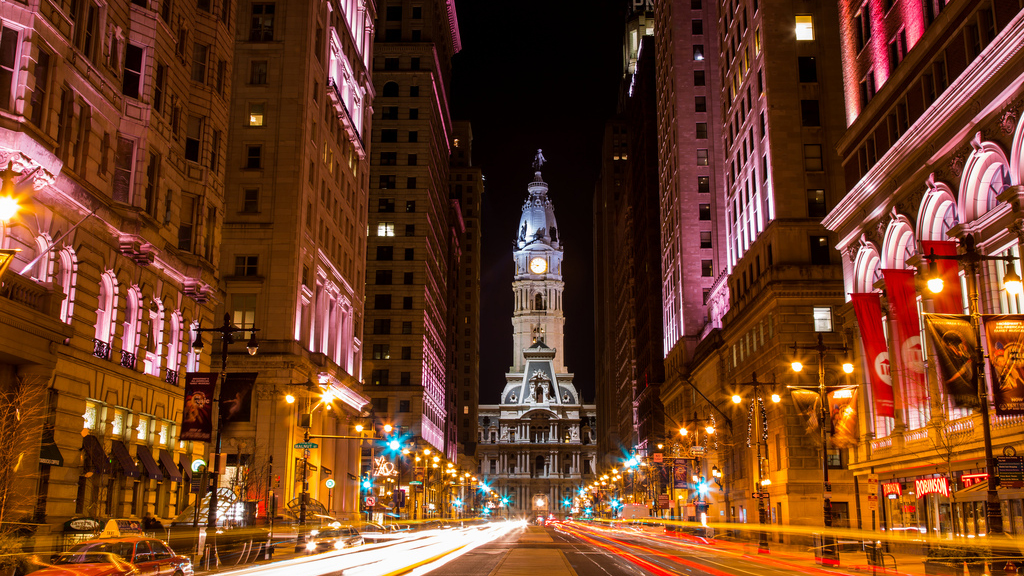
I used to visit Philadelphia for professional reasons from time to time, and whenever I went was forcibly reminded why I’m glad I don’t live in a large East Coast city any more. Traffic, noise, people, confined spaces, high prices and all the concomitant minor irritations that go with those: I have been spoiled by 40 years of living in small towns. I got stiffed for $21 to park for a few hours near the Mutter (though worse was to come in NYC). But if you want to see the skeleton of a man nearly 8 feet tall or a colon the size of a Porsche sedan (plus the picture of the poor sap who was afflicted with it), you gotta go to Philly.
Now that we’re not tied to a rigid schedule we made our drive up rather leisurely, stopping for the night in Morristown, NJ, about an hour from New York. We’d stayed there once before and returned to the same hotel. We found a very nice Persian restaurant not far away, where I ate lamb shanks, one of my favorite dishes, cooked to the point of falling off the bone. Then a good night’s rest, and ho! For the Big Apple.
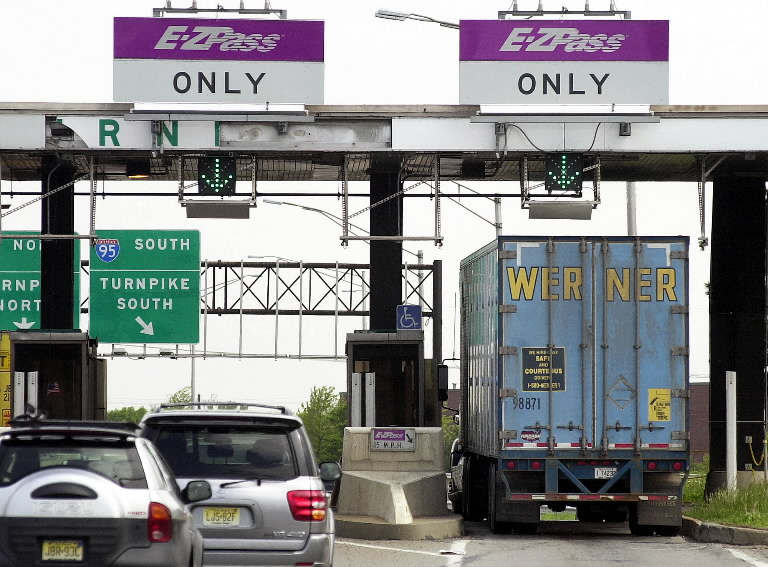 Before we’d left I ordered an “E-Z Pass” transponder from the Virginia Department of Transportation, to deal with the toll bridges and roads that afflict drivers in the East. Most of the major roads in the northeastern US were built before the Interstate Highway system was created, and were funded by tolls. Today, though such places as the Pennsylvania Turnpike and the George Washington Bridge have long since been incorporated into the Interstate system and are recipients of Gasoline Trust Fund money, no one in his right mind would expect the tolls to go away.
Before we’d left I ordered an “E-Z Pass” transponder from the Virginia Department of Transportation, to deal with the toll bridges and roads that afflict drivers in the East. Most of the major roads in the northeastern US were built before the Interstate Highway system was created, and were funded by tolls. Today, though such places as the Pennsylvania Turnpike and the George Washington Bridge have long since been incorporated into the Interstate system and are recipients of Gasoline Trust Fund money, no one in his right mind would expect the tolls to go away.
They’re making staggering amounts of money for local government agencies and politicians are as addicted to the money as any heroin addict is to his “horse.” The tolls will remain forever, and increase every year.
The E-Z Pass system actually gives people a break on the tolls: in cash it costs $14 to cross the George Washington Bridge, but with the transponder the charge is “only” $9.85. And of course the transponders aren’t in labor unions, they don’t get sick, and they work 24 hours a day without pay. What’s not to like? Another advantage is that they do in fact cut down the time spent waiting to go through a toll booth. Crossing the Hudson into Manhattan can involve an hour’s wait at the toll booth during certain times of day, but with an E-Z Pass you roll up to the gate, the light turns green, and you’re off. We timed our departure from Morristown so that we missed the inbound rush hour, and breezed onto the southbound West Side Highway an hour after we left our hotel. Piece of cake.
On the recommendation of our neighbors we booked a room at the Lucerne Hotel on 79th Street, between Amsterdam Avenue and Broadway. There could not have been a more convenient location for yokel tourists like us. First, it was on the #1 IRT subway line, whose dank corridors and smelly cars were a near-daily experience of my youth. The Broadway/7th Avenue IRT is oldest line in the city (built in 1904 and completed in 1911) and at its northernmost end it runs a block from my old house in Kingsbridge. I was intimately familiar with that line, though I must say that these days there has been a vast improvement from 30-40 years ago.
For one thing, the cars are clean. There is none of the graffiti that defaced them (and the stations) in the 70’s and 80’s when the vandalism trend started. 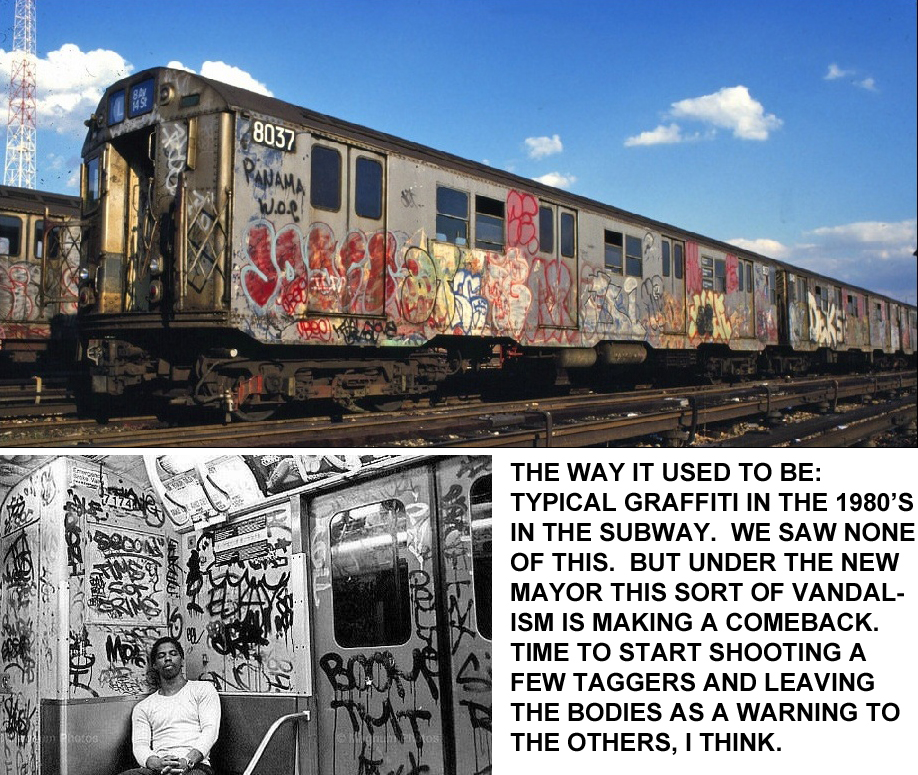
The stations have been cleaned up, there were no drunks, no one was smoking, and the cars were actually air-conditioned. Of all the things about NYC that I was surprised by on this trip, the condition of the subways was the most gratifyingly welcome. The subway is NYC’s circulatory system: the city simply couldn’t function without it. But it took a great deal of courage and effort on the part of the City authorities to clean it up to the point where people want to ride it, instead of riding because there is no other option. This improvement is most attributable to the “broken windows” theory of policing and the get-tough stance on crime instituted by former Mayor Rudy Giuliani and Police Commissioner Bill Bratton. Both of them should have statues at Times Square, I think. Subsequent administrations have maintained the policy though recently the very far-Left new Mayor De Blasio has announced his decision to stop prosecuting petty offenses like turnstile jumping and graffiti spraying. This bodes ill.
The Upper West Side, where the Lucerne is located, was also totally free of graffiti. I don’t know what the Bronx is like these days, but I saw none of it near our hotel. Another amazing thing is that just about every third resident of the neighborhood has a dog, ranging in size from Chihuahuas to Great Danes (lots of Labs and German Shepherds) and there was zero dog shit on the streets. None. I was looking for it, and it simply wasn’t there. I saw people carrying those little bag-holders on the leashes, and actually using the bags to pick up after their animals.
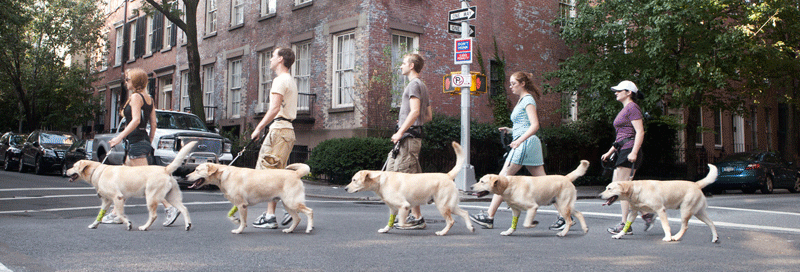
This too is something I never expected. NYC has long had the policy (announced on signs) of “Curb Your Dog,” which most people in my day felt meant, “It’s OK if your dog shits in the street, but keep it off the 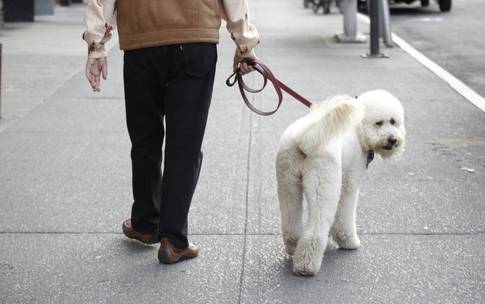 sidewalk.” I’d also forgotten how common dogs are in the city. I knew plenty of apartment dwellers who had dogs, and I suppose even today most landlords are pretty willing to accept them. This is far from the case where I live now, actually.
sidewalk.” I’d also forgotten how common dogs are in the city. I knew plenty of apartment dwellers who had dogs, and I suppose even today most landlords are pretty willing to accept them. This is far from the case where I live now, actually.
There was very little in the way of a police presence on the Upper West Side. I don’t think we saw even three patrol cars and certainly no beat cops on foot. There were plenty of cops in lower Manhattan, but in the quiet neighborhood around the Lucerne the police were no doubt watching from out of sight.
No one with any sense would drive in Manhattan if he could avoid doing so, and from the first we’d decided to rely on the subway a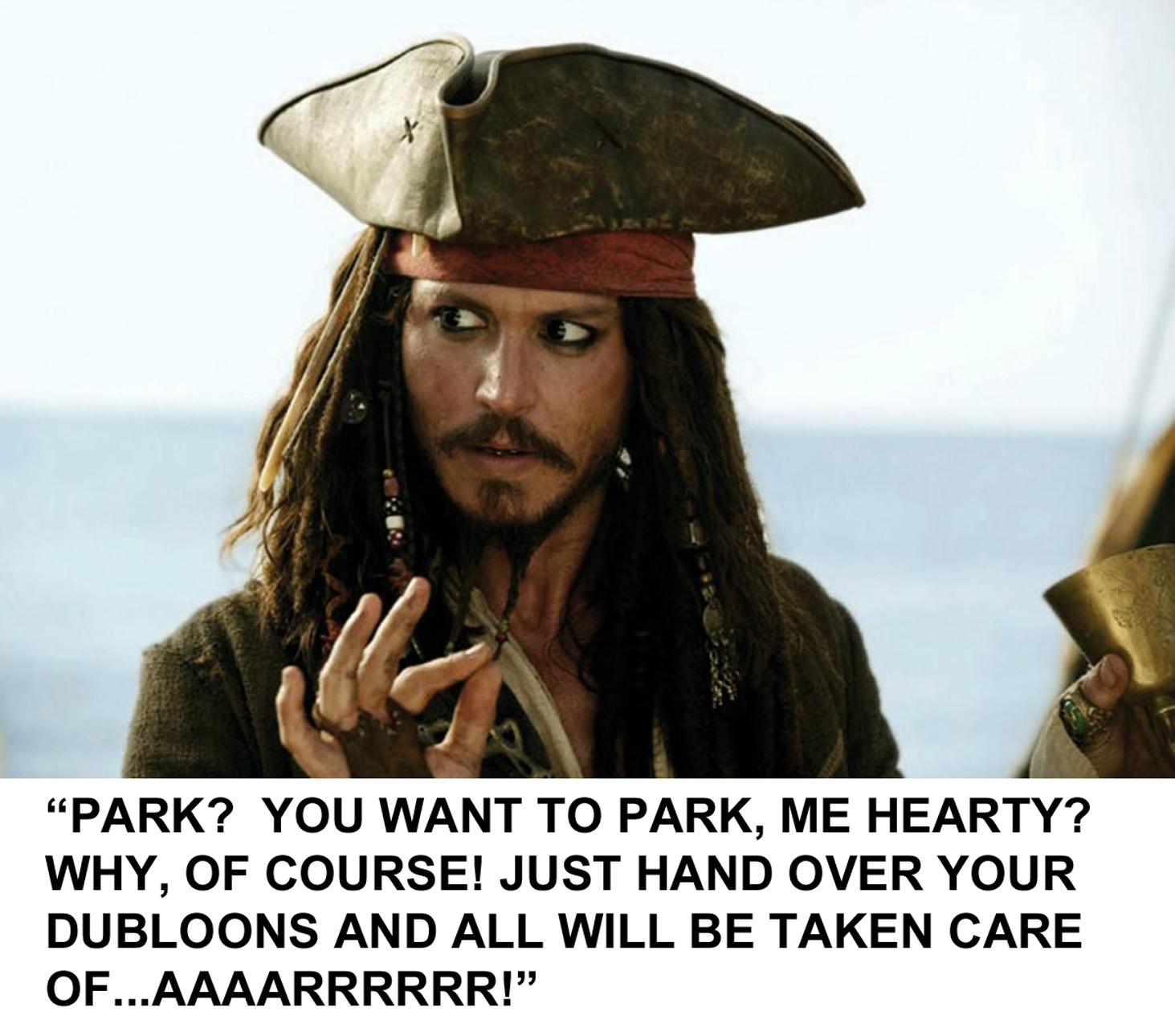 nd the buses to get around. Across from the hotel was a parking garage, run by people who were probably descended from pirates and extortionists.
nd the buses to get around. Across from the hotel was a parking garage, run by people who were probably descended from pirates and extortionists.
Our Kia van was, we were told, “oversized” and so instead of the mere $45 per day they would have charged had we arrived in, say, a Geo Metro or a Toyota “Pious,” we got hit with an additional $10 a day, and none of this in-and-out stuff, either. Once in it stayed in, and if you took it out and brought it back…another $55 please, thank you, sir. In any event parking was cheaper than having to bail the van out of an impoundment lot, so we gritted out teeth and paid the pirates $165 (plus tax!) for the privilege of occupying one of their spaces. Of course we had to surrender the key: Susan said, “I hope they don’t go joyriding!” to which I replied that no one was likely to go joy-riding in a Kia mini-van, and in any event, joyriding in Manhattan traffic meant going about 15 miles per hour. At the end of the stay we paid the ransom and our van was in fact returned without a scratch and surprisingly enough, with the battery, tires, and headlights still in place.
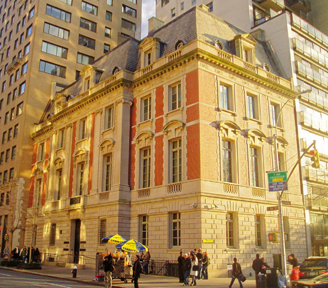 We went to NYC for Culture, and by God, we got Culture up the gazoo. The first stop was the Neue Galerie, which is the permanent home of the famous Klimt painting, “Portrait of Adele Bloch-Bauer,” popularly referred to now as “The Woman In Gold,” thanks to the movie with Helen Mirren. We rode the 86th Street crosstown bus to get there. In my youth I always distrusted buses because I never knew where they would stop, but again, NYC has made great strides. The stops are very plainly marked, there’s a map on the wall of the bus, and the buses are clean and air-conditioned, too. We’d bought fare cards good for unlimited rides on both bus and subway lines and got our money’s worth out of them.
We went to NYC for Culture, and by God, we got Culture up the gazoo. The first stop was the Neue Galerie, which is the permanent home of the famous Klimt painting, “Portrait of Adele Bloch-Bauer,” popularly referred to now as “The Woman In Gold,” thanks to the movie with Helen Mirren. We rode the 86th Street crosstown bus to get there. In my youth I always distrusted buses because I never knew where they would stop, but again, NYC has made great strides. The stops are very plainly marked, there’s a map on the wall of the bus, and the buses are clean and air-conditioned, too. We’d bought fare cards good for unlimited rides on both bus and subway lines and got our money’s worth out of them.
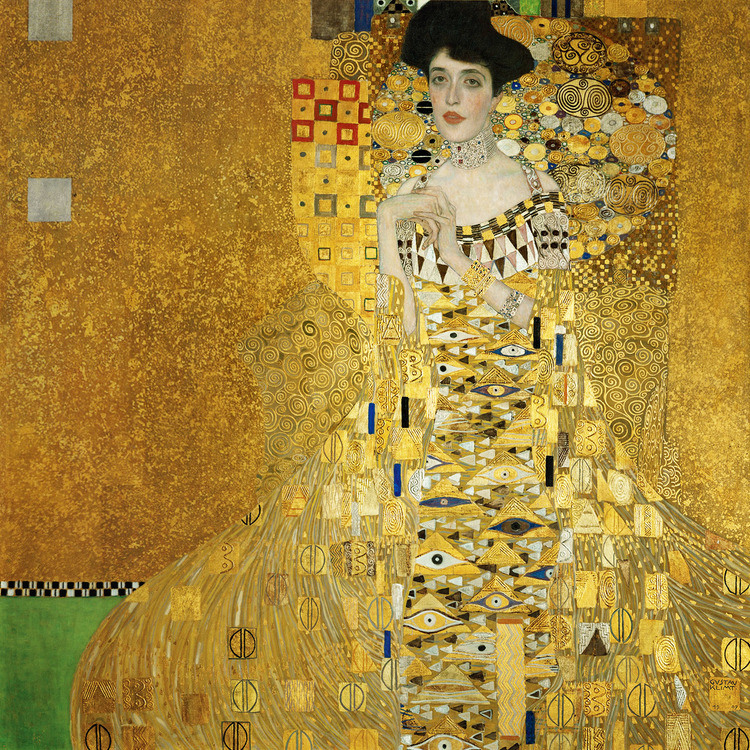
The story of the Klimt painting is well known: how it was seized by the Nazis and how Maria Altman, Adele Bloch-Bauer’s niece, spent 10 years fighting with the postwar Austrian government to recover ownership. (The details are in the book Lady In Gold and in the film.) The painting hung in the Belvedere Museum in Vienna for many years and Altman brought lawsuits in both US and Austrian courts to get it returned. She then promptly sold it to the Neue Galerie for untold millions of dollars. I must say (and I did, when I saw it) that this painting looks exactly like the prints of it I’ve seen. I’m not much on Modern Art, and while this painting is at least recognizable as that of a real person, I wasn’t hit square between the eyes and fair ‘mazed by it, which seems to be its effect on some people. No doubt Klimt was a Great Artist but to my way of thinking he wasn’t as good as, say, N.C. Wyeth. Still, there it is: we had come to see it and we did, along with many other paintings by Klimt. We’d been smart enough to get there 45 minutes before the Galerie opened, and a good thing too: by the time we left a couple of hours later there was a long line of people around the block onto 5th Avenue, waiting their turn.
The Neue Galerie is a block or two below the Metropolitan Museum of Art, another place my parents used to take us as children. So in our relentless pursuit of Culture we hoofed it to the MMA, and there dove into the vast hordes of other tourists, including perhaps half the population of Beijing. It seems the MMA was having a special exhibit on China, and the People’s Democratic Commissar of Art had commanded all Chinese nationals in the USA to visit the exhibit, preferably all at once. The MMA was wall to wall visitors. I recently read that this is the most visited Museum in NYC, with something on the order of 6.3 MILLION visitors in 2014. They’re on track to break that record in 2015, no doubt.
We traipsed around this Palace of Culture for several hours, and while I didn’t get to see everything I wanted to (I did manage the Arms & Armor Collection) we did see the section on European Paintings by Dead White Males and an exhibit on Art of the Deccan Age in India. Since I had briefly lived on the Deccan Plateau years ago, this was a must-see. Unfortunately I missed the exhibit of John Singer Sargent paintings. Sargent specialized in portraits of very rich people, mostly women, and made a tidy living at it in the late 19th and early 20th Century. I’ve always admired the work of this fine painter, who was almost as good as N.C. Wyeth.
In the early years of our marriage Susan and I went to Greenwich Village one day for dinner to a Spanish restaurant, named (very fittingly) “Spain.” It’s on 13th Street, and lo, there is an IRT stop right nearby. That evening we re-lived part of our younger days and I overindulged in paella. At the end of this very long day it was back to the Lucerne to collapse in a flurry of ashes so that next day we could do it again.
The second day was for Science, not Culture. We were within walking distance of the American Museum of Natural History, another of my youthful haunts, so off we went to spend 5-1/2 hours looking at stuffed birds and animals. Again, the place was packed wall to wall with tourists by the time we left.
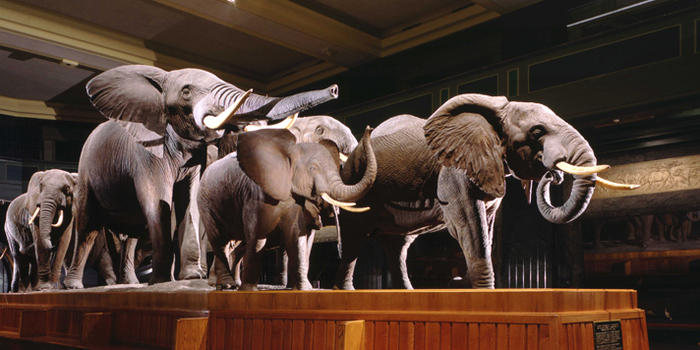
One exhibit in particular we wanted to see was a taxidermy group of elephants entitled “The Alarm,” the centerpiece of the African Mammals Hall. About 8 of them, standing stock still, one of them with its trunk elevated and perpetually sniffing the air for danger. Since this particular elephant has been on display at the AMNH for about 75 years, he obviously wasn’t alert enough. The Big Elephant in the group was a fine bull: what is known as a “hundred pounder,” based on the weight of one of his tusks. Elephant like that are few and far between these days! We also saw lots of North American Mammals and a display on evolution that carefully walked a middle ground between scientific fact and religious objections: quite well done.
After recuperation from the AMNH we rode the bus up Broadway to a jazz club called “Cleopatra’s Needle,” after the famous obelisk behind the MMA a couple of blocks away. It was “open mike” night and the trio (a pianist, drummer, and bassist) played while various geriatric patrons got up to sing. We ate there that evening. I had always envisioned jazz clubs as smoky dens filled with ominous people wearing dark glasses, but this wasn’t one of those. In fact there are no more smoky dens, not even in jazz venues. It is quite literally a crime in NYC to smoke indoors so the dark places that used to host such jazz greats as The Monk and Dizzy are now gone. Sic transit gloria mundi.
But we had fun and a decent meal, and the people singing were all pretty good. One of the patrons had obviously been a professional musician, and he played the clarinet with the trio, as his wife sang. Then he sang “Sweet Lorraine” (his wife’s name, I suppose), packed up his clarinet and they left. I classify this evening as part of the Culture expedition.
The next day was for History and Heritage. We took the IRT down to South Ferry in lower Manhattan, and there embarked on a ferry ride to the Statue of Liberty and Ellis Island. Unfortunately no one had told us that the only way to get into the Statue was to make advance reservations, so we were only able to walk around the base and look up, but that was enough. The ferry stopped at the Statue first, so we re-boarded and went to Ellis Island.
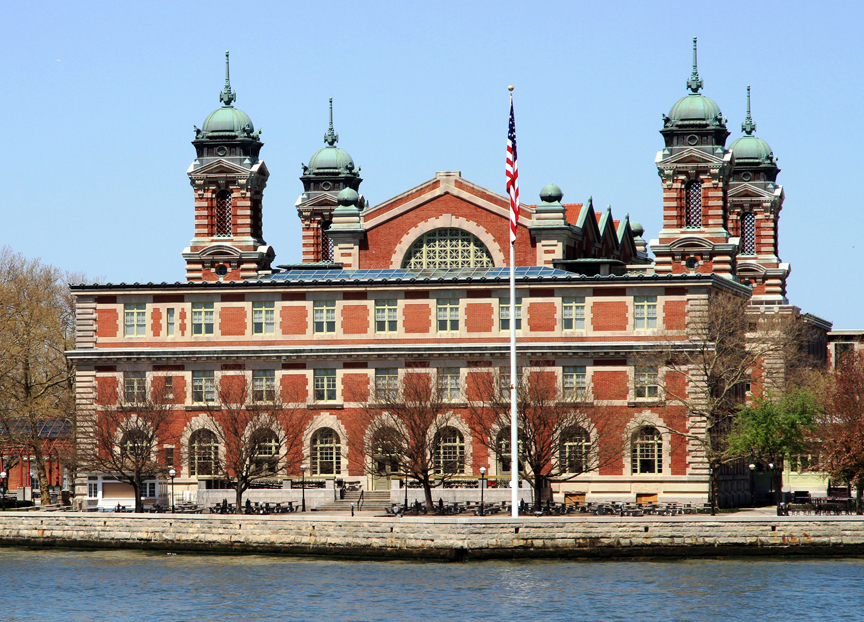
I had never been there before. We tried to get to it in late 2001 but there four-hour waits for tickets so we gave up. Once again we made it a point to arrive as early as possible and caught the second boat out of Battery Park. The boat was leaping ominously in the swell as it lay against the pier, causing Mrs NRVO some misgivings, as she is subject to motion sickness, but it was a short ride and nothing happened.
There is a family story that when my father’s mother came to America a year after her fiancé (my grandfather) she refused to go to the mainland until she had been properly married, in front of a priest; and that there were priests who performed such services for newly-landed immigrants. I don’t know if this is really true (though I hope it is, what could be more romantic than to get married in a huge barnlike building swarming with the “huddled masses” and starting out for a new life on a rocking ferry boat?) but it is a fact that all of my more recent ancestors entered through The Great Gateway between 1903 and 1913, passing under Lady Liberty’s torch. So I had long wished to see the place where they landed.
The Ellis Island Immigrant Station has been turned into a museum, mostly dedicated 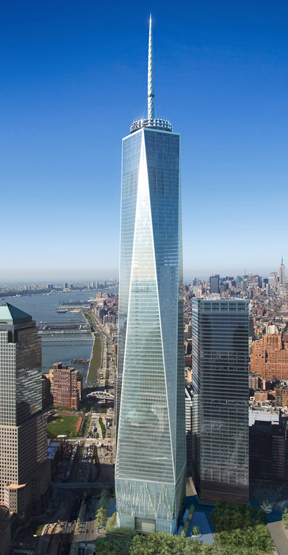 to immigration, but as is more or less mandatory these days there are plenty of Politically Correct exhibits regarding the oppression and enslavement of various segments of the American population on the first floor. Now, the station opened in 1892, long after most of the events covered by these PC displays had ended, but they had to be there. The second and third levels were in fact devoted to the processes of bringing in new immigrants and were far more interesting than the first floor, so far as I was concerned. That’s what Ellis Island is about.
to immigration, but as is more or less mandatory these days there are plenty of Politically Correct exhibits regarding the oppression and enslavement of various segments of the American population on the first floor. Now, the station opened in 1892, long after most of the events covered by these PC displays had ended, but they had to be there. The second and third levels were in fact devoted to the processes of bringing in new immigrants and were far more interesting than the first floor, so far as I was concerned. That’s what Ellis Island is about.
Since we were in lower Manhattan, we decided to walk to the Freedom Tower, the building put up adjacent to the site of the late World Trade Center. Susan regards the construction of this immense and very impressive building as “the triumph of good over evil,” and I suppose it is; but it took 15 years of wrangling and arguing to get it built. Moreover there is airport-type security there (as also on the ferry to the Statue) so in some ways the terrorists won. Nevertheless the Freedom Tower is quite a place. It was a hell of a hike from Battery Park, though the building is so large is seems much closer than it is.
There’s an observation platform on the 100th floor, and we rode what is reputed to be the world’s fastest elevator up to it. A 2-minute film introduced what we were about to see, culminating in the removal of the screen so that we could see the panorama below. Then we went to the actual observation deck. I don’t know how far away the horizon is on a clear day, but even though there was haze in the distance I could make out the George Washington Bridge at 181st Street easily. All five boroughs and three states are allegedly visible from the deck. If you get hungry or thirsty the operators of this “One World” observation platform (who are undoubtedly related to the pirates running the parking garage) will be glad to accommodate you with snacks and drinks: we spent $12 for a peach, a small yogurt, and a bottle of water. No one ever said it was going to be easy. Or cheap.
We left about 9:00 AM the following day. We’d dropped the car off at 9:21 on the morning of our arrival and I was anxious not to incur another $55 charge, so I fetched the car and we schlepped our bags down from the hotel. Thanks to the incredibly convenient location on 79th Street we zipped out, hit the West Side Highway, and were over the George Washington Bridge in about 10 minutes! This has to be some sort of record. There’s no toll outbound on the Bridge, which sped things up a lot. On the way back down we bypassed Morristown and drove to Staunton VA, spent the night at the Stonewall Jackson Hotel, and sucked up some more Culture at the American Shakespeare Theatre next door. Home to Blacksburg the following day after a stop at a winery off I-81 and a movie in Roanoke (“Mr. Holmes,” well worth seeing).
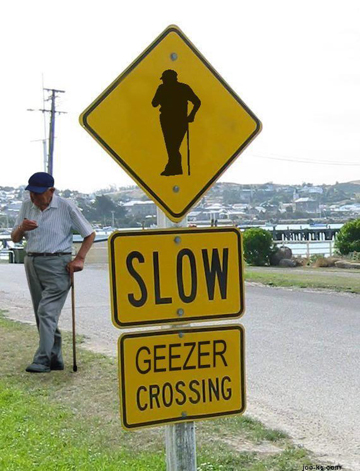 In summary, it was a very good trip. Everything went smoothly, and everyone we encountered was helpful and cheery: not the “surly Noo Yawkuh” stereotype at all. In the course of the trip I learned the advantages of carrying a walking stick about. I have a collapsing stick I bought in Alaska, and used it every day on the not-so-mean-anymore streets, “just in case.” But I found that when you’re a Geezer with a white beard and a stick, people will get up and give you seats in crowded subway cars, and treat you with substantial deference. I’ll make it a point to be “disabled” every time I go again!
In summary, it was a very good trip. Everything went smoothly, and everyone we encountered was helpful and cheery: not the “surly Noo Yawkuh” stereotype at all. In the course of the trip I learned the advantages of carrying a walking stick about. I have a collapsing stick I bought in Alaska, and used it every day on the not-so-mean-anymore streets, “just in case.” But I found that when you’re a Geezer with a white beard and a stick, people will get up and give you seats in crowded subway cars, and treat you with substantial deference. I’ll make it a point to be “disabled” every time I go again!
We had a lot of fun sitting in sidewalk restaurants or near windows, watching people walking up and down the streets of the Upper West Side going about their daily routines. I mentioned how many people were walking dogs: all the dogs were well-behaved and never did they bark or lunge at one another. Canis upperwestsideus seems to be nearly as polite as the dogs we saw in Canada. I also note with some degree of satisfaction that there is clearly an ongoing Renaissance of the mini-skirt and microscopic shorts on women, at least one or two of whom felt that underwear was entirely superfluous and could be dispensed with. In addition to the perfect weather, this generous spirit added a great deal of visual interest to people-watching.
The Urban Life is so different from where and how we live now that I doubt I could ever do it again, but we had a lot of fun. We will certainly go again: we’ve been thinking about spending a few days up there while the Metropolitan Opera is in session, in Winter. Lincoln Center is just two stops downtown from the Lucerne on the reliable old 7th Avenue IRT Line!
| HUNTING | GUNS | DOGS |
| FISHING & BOATING | TRIP REPORTS | MISCELLANEOUS ESSAYS |
| CONTRIBUTIONS FROM OTHER WRITERS|
| RECIPES |POLITICS |